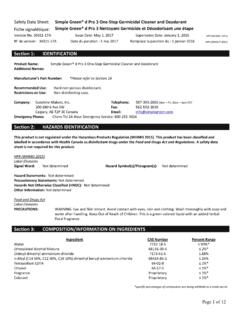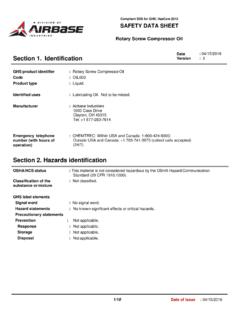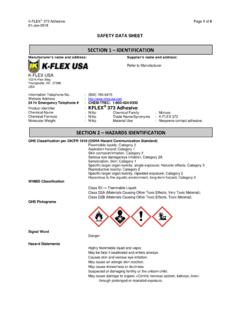Transcription of Section 1 - Identification* * * - ScrapConnect
1 Safety Data SheetProduct Identifier: Carbon Steel ScrapSDS ID : FE-0101_____Page 1 of 11 Issue Date 05/18/15 Revision Date: 05/18/15* * * Section 1 - identification * * *Product Identifier:Carbon Steel ScrapChemical Family:MixtureRecommended Use:Scrap metal on Use:None InformationThe David J. Joseph Company300 Pike StreetCincinnati, OH 45202 Non-Emergency Contact: Safety Department Non-Emergency Phone: 513-419-6200 Emergency Contact: DJJ Emergency Phone: 513-562-1699* * * Section 2 - Hazard(s) identification * * *Classification in accordance with 29 CFR is supplied as scrap metal consisting of iron. This alloy is a non-combustible, non-reactive solid material. Solidmaterial, as supplied, is not hazardous. Processing of this material may produce hazardous vapors, fumes, mists and dustswhich are considered hazardous under 29 CFR (Hazard Communication). Dust, particles or powder generatedduring processing would have the following classification:Acute Toxicity (Oral), Category 4 Skin Corrosion / Irritation, Category 2 Toxic to Reproduction, Category 1 BSpecific Target Organ Toxicity - Single Exposure, Category 1 (respiratory system)Specific Target Organ Toxicity - Repeated Exposure, Category 1 (nervous system)GHS LABEL ELEMENTSS ymbol(s)Signal WordDANGERH azard Statement(s)Harmful if swallowedCauses skin irritationMay damage fertility or the unborn childCauses damage to respiratory damage to nervous system through prolonged or repeated Data SheetProduct Identifier: Carbon Steel ScrapSDS ID : FE-0101_____Page 2 of 11 Issue Date 05/18/15 Revision Date: 05/18/15 Precautionary Statement(s)PreventionObtain special instructions before use.
2 Do not handle until all safety precautions have been read and understood. Do notbreathe dust, mist, fumes or vapors. Do not eat, drink, or smoke when using this product. Wear appropriate protectivegloves/clothing and eye/face protection if contact is possible. Wash thoroughly after ON SKIN: Wash with plenty of soap and water. If skin irritation occurs: Get medical advice/attention. Take offcontaminated clothing and wash before re-use. IF SWALLOWED: Call a POISON CENTER or doctor/physician if you feelunwell. Rinse mouth. IF exposed or concerned: Get medical in a secure of material in accordance with all local, regional, national and international (s) Not Otherwise ClassifiedDust may present an explosion hazard if allowed to accumulate in an industrial or manufacturing environment. Coatings andoils applied to the product may enhance flammability.* * * Section 3 - Composition / Information on Ingredients* * *CASC omponentPercent7439-89-6 Iron>967440-44-0 Carbon<27439-96-5 Manganese<2 Component Related Regulatory InformationThis product may be regulated, have exposure limits or other information identified as the following: Iron oxide (1309-37-1).
3 Component Information/Information on Non-Hazardous ComponentsProcessing of this material may produce hazardous vapors, fumes, mists and dusts which are considered hazardous under 29 CFR (Hazard Communication).May contain trace amounts of nickel, cobalt, copper, vanadium, zirconium, lead, aluminum, chromium, niobium, silicon,calcium, tin, titanium, arsenic, boron, and data sheet is prepared as a guideline for typical uses of scrap materials. The user should be aware that the compositionof the scrap can vary based upon the raw materials, processes used, and protective coatings that may have been applied to theoriginal materials. The list of ingredients above are typical ingredients thought to be present in the scrap material. This listincludes contaminants that may or may not be present. The percentages given vary from shipment to shipment and may notbe entirely accurate for a given coatings, including paints, lubricants, corrosion inhibitors, etc., may have been applied to the material before itcame under the control of the recycler.
4 These coatings may contain hazardous materials. Typical hazardous materialscontained in these coatings include: lead, zinc, chromium, and cadmium. Some organic materials may also be present. Thesupplier (recycler) may have no specific knowledge of the particular contaminant. However, it is anticipated that thehazardous materials present in the coatings would generally represent less than of the total material present. The healthhazards presented by these contaminants would produce their greatest potential for exposure during processes such asmelting, cutting, welding. These processes could generate metal fumes that might produce the health hazards identified insection 2 of this Data SheetProduct Identifier: Carbon Steel ScrapSDS ID : FE-0101_____Page 3 of 11 Issue Date 05/18/15 Revision Date: 05/18/15It is suggested that the user protect employees by utilizing engineering controls that reduce exposures to acceptableconcentrations. Where engineering controls are not feasible, appropriate personal protective equipment should be utilized.
5 * * * Section 4 - First Aid Measures* * *Description of Necessary MeasuresInhalationIf adverse effects occur during processing, remove to uncontaminated area. Get immediate medical ContactWash with plenty of soap and water. If skin irritation occurs: Get medical advice/attention. Take off contaminated clothingand wash before reuse. Cuts or abrasions should be treated promptly with thorough cleansing of the affected ContactRinse cautiously with water for several minutes. Remove contact lenses, if present and easy to do. Continue rinsing. If eyeirritation persists, get medical advice/attention. In case of mechanical abrasions and cuts, seek medical attention to the physical nature of this material, ingestion is unlikely to occur. If ingestion of a large amount does occur, seekimmediate medical attention. Do not induce vomiting unless told to do so by the poison control center or Important Symptoms/EffectsAcuteProcessing by-products: Harmful if swallowed.
6 Symptoms/effects may include skin irritation and respiratory system by-products: Symptoms/effects may include nervous system damage and reproductive of immediate Medical Attention and Special Treatment NeededTreat symptomatically and supportively.* * * Section 5 - Fire Fighting Measures* * *Extinguishing MediaMedia to use includes regular dry chemical and dry Extinguishing MediaMolten metal may react violently with Hazards Arising from the ChemicalCoatings and oils applied to the product may enhance flammability. Dust or fine particles may present a flammability hazardif allowed to accumulate in an industrial or manufacturing Combustion ProductsThis product may release metal oxide fumes by thermal fighting measuresFight fire with normal precautions from a reasonable distance. Cool materials with water spray until well after the fire is Protective Equipment and Precautions for FirefightersFire fighters should wear full-face, self contained breathing apparatus and impervious protective clothing.
7 Fire fightersshould avoid inhaling any combustion products.* * * Section 6 - Accidental Release Measures* * *Personal Precautions, Protective Equipment and Emergency ProceduresIf dusts or particulates are generated, eliminate sources of ignition. Wear personal protective clothing and equipment, seeSection Data SheetProduct Identifier: Carbon Steel ScrapSDS ID : FE-0101_____Page 4 of 11 Issue Date 05/18/15 Revision Date: 05/18/15 Methods and Materials for Containment and Cleaning UpContainment of this material should not be necessary. If dusts or particulates are generated, eliminate sources of pieces of this product may be collected with a broom and shovel. Collect spilled material in appropriate container forreuse or disposal.* * * Section 7 - Handling and Storage* * *Precautions for Safe HandlingObserve good hygiene and safety practices when handling this product. Processing of this material may produce hazardousvapors, fumes, mists, and dusts. Avoid inhaling dusts or fumes produced during product processing.
8 Handle with adequateventilation during processing. Wash thoroughly after for Safe storage, Including any incompatibilitiesStore in a secure iron wire burns in chlorine gas, iron reacts with chlorine trifluoride and calcium hypochlorite, powdered iron reacts withfluorine below redness with incandescence, violent decomposition of hydrogen peroxide may be caused by contact with iron,reduced iron decomposes nitrogen dioxide at ordinary temperatures with incandescence.* * * Section 8 - Exposure Controls / Personal Protection* * *Exposure LimitsFollow all applicable exposure limits. Keep formation of dusts, particulates and fumes to a Data SheetProduct Identifier: Carbon Steel ScrapSDS ID : FE-0101_____Page 5 of 11 Issue Date 05/18/15 Revision Date: 05/18/15 Component Exposure LimitsIron (7439-89-6)ACGIH:5 mg/m3 TWA (respirable fraction, related to Iron oxide)OSHA:10 mg/m3 TWA (fume); 15 mg/m3 TWA (total dust); 5 mg/m3 TWA (respirablefraction, related to Iron oxide)NIOSH:5 mg/m3 TWA (as Fe, dust and fume, related to Iron oxide)Alberta:5 mg/m3 TWA (respirable, related to Iron oxide)British Columbia:10 mg/m3 TWA (total particulate matter containing no Asbestos and <1% Crystallinesilica, total particulate); 3 mg/m3 TWA (particulate matter containing no Asbestos and<1% Crystalline silica, respirable particulate).
9 5 mg/m3 TWA (as Fe, dust and fume,related to Iron oxide)10 mg/m3 STEL (as Fe, fume, related to Iron oxide)Manitoba:5 mg/m3 TWA (respirable fraction, related to Iron oxide)New Brunswick:5 mg/m3 TWA (as Fe, particulate matter containing no Asbestos and <1% Crystallinesilica, dust and fume); 10 mg/m3 TWA (regulated under Rouge, particulate mattercontaining no Asbestos and <1% Crystalline silica, related to Iron oxide)NW Territories:5 mg/m3 TWA (respirable mass); 10 mg/m3 TWA (total mass, related to Iron oxide)Nova Scotia:5 mg/m3 TWA (respirable fraction, related to Iron oxide)Nunavut:5 mg/m3 TWA (respirable mass); 10 mg/m3 TWA (total mass, related to Iron oxide)Ontario:5 mg/m3 TWA (respirable, related to Iron oxide)Quebec:5 mg/m3 TWAEV (as Fe, dust and fume); 10 mg/m3 TWAEV (containing noAsbestos and <1% Crystalline silica, regulated under Rouge, total dust, related to Ironoxide)Saskatchewan:5 mg/m3 TWA (as Fe, dust and fume); 10 mg/m3 TWA (regulated under Rouge,related to Iron oxide)10 mg/m3 STEL (as Fe, dust and fume); 20 mg/m3 STEL (regulated under Rouge,related to Iron oxide)Yukon:5 mg/m3 TWA (as Fe2O3, fume); 30 mppcf TWA (regulated under Rouge); 10 mg/m3 TWA (regulated under Rouge, related to Iron oxide)10 mg/m3 STEL (fume); 20 mg/m3 STEL (regulated under Rouge, related to Ironoxide)Manganese (7439-96-5)Safety Data SheetProduct Identifier: Carbon Steel ScrapSDS ID : FE-0101_____Page 6 of 11 Issue Date 05/18/15 Revision Date: 05/18/15 mg/m3 TWA (respirable fraction); mg/m3 TWA (inhalable fraction)OSHA:5 mg/m3 Ceiling (fume)NIOSH:1 mg/m3 TWA (fume)3 mg/m3 mg/m3 TWAB ritish Columbia:Adverse reproductive mg/m3 mg/m3 TWA (respirable fraction); mg/m3 TWA (inhalable fraction)New mg/m3 TWANW Territories:1 mg/m3 TWA (fume)3 mg/m3 STEL (fume)5 mg/m3 CeilingNova mg/m3 TWA (respirable fraction).
10 Mg/m3 TWA (inhalable fraction)Nunavut:1 mg/m3 TWA (fume)3 mg/m3 STEL (fume)5 mg/m3 mg/m3 mg/m3 TWAEV (total dust and fume) mg/m3 mg/m3 STELY ukon:5 mg/m3 CeilingAppropriate Engineering ControlsFor outdoor applications, special ventilation is not required under normal conditions of use. Under normal conditions of use,no special ventilation equipment is needed. Ventilation should be sufficient to effectively remove and prevent buildup of anydusts or fumes that may be generated during handling or thermal Protection Measures, such as Personal Protective EquipmentEyes/Face ProtectionEye protection not required under normal conditions. Wear appropriate eye protection if eye contact is ProtectionWear gloves and other clothing as required to avoid ProtectionConsult with a health and safety professional for specific respirators appropriate for your use. When dusts or thermalprocessing fumes are generated and ventilation is not sufficient to effectively remove them, appropriate NIOSH approvedrespiratory protection must be provided.










